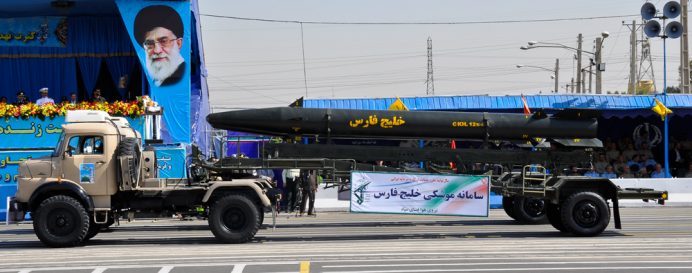Fathom Deputy Editor Calev Ben-Dor critiques the assessment – widespread in western analytic circles – that the Iranian attack was precisely designed to pose no threat to life and to inflict minimal damage. Drawing on interviews with experts, Ben-Dor argues that ‘those claiming a type of inverse Pyrrhic victory – in which the failure of 99 per cent of missiles and drones to do damage actually constitute proof of success and strategic genius – should think again.’
Saturday night may become a historic turning point in the ongoing battle between Israel and the Islamic Republic of Iran, as the latter launched 170 drones, 30 cruise missiles and 110 ballistic missiles – the first time Iran has attacked Israel from its own territory.
Due to Israel’s multi-layered missile defence system, as well as significant help from the US and other Western and regional allies, 99 per cent of the Iranian armada failed to penetrate Israeli airspace. Five ballistic missiles impacted on Israeli territory, with four of them landing in the Nevatim airbase where the country’s F-35 fighter jets are based.
Iran’s foreign minister, Hossein Amirabdollahian, called the attacks ‘limited’ and for ‘self defence’, describing it as a response to the 1 April Israeli strike on a building adjacent to the Iranian consulate in Damascus which killed Gen Mohammad Reza Zahedi, a senior figure in Iran’s Islamic Revolutionary Guards, and eight other officers. Iran subsequently celebrated the success of its attack at an annual military parade which, according to President Ebrahim Raisi ‘brought down the glory of the Zionist regime.’
Such rhetoric is unsurprising coming from the sycophantic Islamist humpty dumpty world in Tehran, where words mean whatever the Grand Leader chooses them to mean. Harder to comprehend though is an array of commentators who claimed the Iranian attack was primarily spectacle (and by implication successful).
The New York Times referred to a ‘highly choreographed spectacle’ designed to create ‘maximum drama with minimum casualties’. Max Boot in the Washington Post called it a ‘performative strike’ designed to ‘make a statement, not to inflict mass casualties.’ Al Jazeera quoted Hassan Barari, Professor of International Relations at the University of Qatar, who explained the Iranian attack had been ‘carefully calibrated.’ And in this journal, Kyle Orton argues that ‘the Iranian attack was not intended to be militarily significant. The intent was symbolic, and the Iranians might well gain from that.’ (Emphasis in original.)
More convincing to my mind is that if a country fires hundreds of projectiles (in a similar pattern to Russia’s deadly use against Ukraine) at an enemy’s strategic airbases, perhaps they intended to…actually hit and damage them.
This second approach doesn’t confuse results with intentions. ‘When you acquire all sorts of military weaponry and decide to use it you want to show it is effective’ Ambassador Dennis Ross explained to Fathom. ‘If this was just a statement, Iran would have sent a fraction of what they fired. Their aim was to try and inflict real damage on Israel and at the same time to rewrite the rules.’
Two key parameters can help us understand the strikes’ significance and seriousness. One is their point of origin – primarily from Iranian territory rather than via proxies (although missiles were also fired from Iraq and Yemen). The second is the quantity. ‘I’m not willing to describe a situation in which Iran fires over 300 drones, ballistic and cruise missiles from their own territory as purely symbolic’ Raz Zimmt, researcher at the Alliance Center for Iranian Studies at Tel Aviv University, tells Fathom. ‘I don’t see how this can be understood as a calibrated attack intended to prevent escalation’ he adds.
Escalation is a spectrum. So it’s worth clarifying that Iran almost certainly didn’t seek to generate an all-out regional war with US involvement (something it very much fears) and therefore sought to avoid civilian casualties (it partially failed here as well – one young Bedouin girl remains fighting for her life). It seems obvious Iran would have been happy had it damaged Israeli F-35s and airforce runways. And it very much did want to draw a line in the sand and change Israeli decision making considerations, for the Jewish state to understand that every Israeli action on ‘Iranian soil’ will be answered harshly.
In this narrower latter goal, it may have had some success. Danny Citrinowicz, a research fellow at the INSS specialising in Iran, believes that Iran (for now at least) managed to thread the eye of the needle between conflicting strategic aims. ‘On one hand, Iran wanted revenge and to draw a line in the sand, but on other hand, it knew Israel had active defence capabilities and it didn’t want this to escalate into war – certainly one that involves the US,’ he says. ‘The best way to achieve these aims is what Iran ultimately did – choosing secluded targets like Nevatim and the Hermon, and launching large numbers of UAVs and cruise missiles assuming some would bypass Israel’s active defence – inflicting damage but not enough to cause a war.’
Yet even were this the case, intended damage to Israel’s prized arsenal at Nevatim would have caused strategic damage to the Jewish state. And it was quite the risk. ‘Iran may well have operated on the assumption that Israel would be able to deal with most of the missiles and drones, and that there wouldn’t be civilian casualties,’ says Zimmt. ‘But they must have assumed that 10-20 per cent would get through, and must have estimated that those would be able to do a lot of damage.’
A limited act of theatrics and de-escalation this was not.
The extent to which Iran has rewritten the rules vis-à-vis Israel remains to be seen – it will be very much determined by the Israeli response to Saturday’s barrage. But in any event, those claiming a type of inverse Pyrrhic victory – in which the failure of 99 per cent of missiles and drones to do damage actually constitute proof of success and strategic genius – should think again. If the results of the attacks were a blessing for Iran, they were – to paraphrase Churchill when he lost the post-war election – a ‘blessing very effectively disguised.’


































